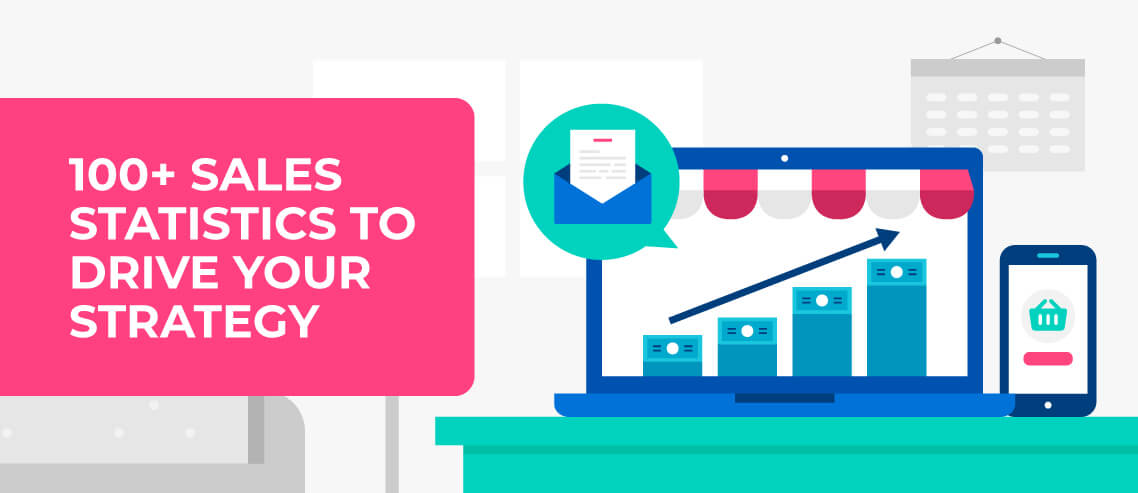100+ Sales Statistics to Drive Your Strategy

Contents
Wondering why you’re not creating as many leads or closing as many sales as your colleagues? Want to know the trick to writing a killer sales email? Need to prove to the C-suite why (and how) you should be shaping up your sales strategy? Here are 100 sales statistics that will help you do all that, and more.
Lead Generation
- Just 8% of salespeople state that the leads generated for them by their marketing teams are of high quality.
- The best-performing sales reps use LinkedIn 6 hours a week for prospecting and connecting with peers.
- 94% of prospects are active on social media …
- … and yet only 5% of B2B sales teams consider social media to be an effective lead generation tool.
- Less than 50% of initial prospects turn out to be a good fit.
- More than ¾ of companies are providing more than ¼ of their sales reps’ leads.
- It’s 6-7 times more expensive to acquire a new customer than to keep an existing one.
- The average company loses 10-30% of its customers each year.
- 55% of B2B buyers search for information on social media.
Writing Sales Emails
- Using a CTA button in place of a link increased click-throughs by 28%.
- Less is more – one study found that click-through rates increased 42% when the number of CTAs in an email decreased from four to just one.
- 47% of emails are opened or discarded based solely on their subject line.
- As of 2016, 55% of emails were opened on mobile devices.
- Using words like “account,” “campaign,” and “next” in the subject line of sales emails has been proven to increase open rates.
- Three of the most ineffective words to include in subject lines are “invite,” “join,” and “confirm.”
- Writing your subject line entirely in upper case significantly reduces response rates.
- Subject lines consisting of three or four words resulted in the highest response rate.
- Personalizing subject lines can increase open rates by 50%.
- Offering recipients a way out doubles the chance of them saying yes.
- Including questions in emails increases response rates by 50%.
- Writing at a third-grade reading level increases response rates by 36%.
- The ideal length of a sales email is between 50 and 125 words.
Sending Sales Emails
- The best time to send an email is between 8am-10am, and 3pm-4pm.
- The best day to send an email is Tuesday.
- 8 out of 10 prospects want to talk to sales reps via email, over any other medium.
- The average person spends 4 hours a week opening, reading, and responding to emails.
- B2C sales emails typically see higher open rates than B2B sales emails. Specifically, B2B open rates average at around 30% and B2C, between 30.5% and 34.9%.
- 89% of marketers say that email is their primary channel for lead generation.
- Email marketing yields an average ROI of 4,300%.
- Email is nearly 40x more effective at new customer acquisition than Facebook or Twitter.
- 70% of salespeople give up if they don’t receive a reply to their first email.
- The average cold email campaign gets less than a 1% response rate.
- Follow-up emails often get a better response rate than the initial email. One study saw an 18% response rate to the first email, 13% to the 4th, and 27% to the 6th. Another study saw a 30% response rate to the first email and 14% to the 4th. Even the 10th email in the sequence got a 7% response rate.
- Open rates vary depending on industry, but the average open rate for emails across all industries is 37%.
Picking Up the Phone
- 92% of all customer interactions take place over the phone.
- 75% of prospects in the C-suite are happy to take sales calls (compared to 64% of directors and 59% of managers).
- You’re 46% more likely to successfully connect with a director when dialing a direct dial number …
- … and you’re 147% more likely to successfully connect when calling a VP’s direct line.
- 80% of phone calls go straight to voicemail, and 90% of first-time voicemails are ignored.
- Despite this, the average sales rep spends 25 hours a month just leaving voicemail messages.
- The ideal length of a voicemail message is between 8 and 14 seconds.
- It takes an average of 18 calls to connect with a buyer.
- Just 2% of cold calls result in an appointment.
- 85% of prospects are dissatisfied with their experiences of talking to sales reps on the phone.
- Sales calls lasting between 6-10 minutes convert at a higher rate (29%) than calls over 10 minutes (22%).
Referrals
- Peer recommendations affect more than 90% of buying decisions.
- Although 91% of customers state they would willingly give a referral, just 11% of sales reps ask for them.
- Sales reps who actively seek out referrals typically earn 4 to 5 times as much as those who don’t.
- 80% of calls with a referred prospect result in a meeting.
- The average lifetime value of a referred customer is 16% higher than that of a non-referred customer.
- Prospects referred by a friend are 4 times more likely to make a purchase.
Lead Nurturing
- Companies that excel at lead nurturing have 9% more sales reps making quota.
- 78% of decision-makers report having arranged an appointment or attending an event as a result of a cold email or call.
- Lead nurturing emails have an average CTR of 8% compared to general emails, which have a CTR of 3%.
- Nurtured leads tend to result in an additional 20% more sales opportunities.
- Businesses that use marketing automation to help nurture prospects see a 451% increase in qualified leads.
- Nurtured leads spend 47% more than non-nurtured leads.
- High-growth organizations report an average of 16 touch points per prospect within a 2-4 week span.
- 63% of prospects who request information today will not buy for at least 3 months. 20% of them will take more than 12 months to buy.
- The average cost of a call to a potential customer is just $33.11. The average cost of going out and visiting them is $276.48.
- 58% of buyers state that sales meetings aren’t valuable, and that there should be a greater focus on the value you can deliver them.
- 69% of buyers state that providing primary research data that’s relevant to their business is the best way for reps to add value.
- According to buyers, the three most important elements of a positive sales experience are a sales representative who 1) listens to their needs, 2) isn’t pushy, and 3) provides relevant information.
- 58% of buyers want to discuss pricing in the first sales call, but only 23% of reps want to discuss it with them.
- 54% of buyers want a product demo on the first call.
- 82% of B2B buyers think sales reps are unprepared.
- Only 19% of buyers want to connect with sales reps during the awareness stage of the sales cycle; 60% of them want to wait until they reach consideration stage.
- 95% of customers choose to buy from providers that offer relevant content at every stage of the buying process.
- The best-performing sales reps use collaborative words like “we” or “us” instead of words like “I” or “me.”
- Following a presentation, 63% of prospects remember stories, but just 5% remember statistics.
- 9 out of 10 B2B buyers say online content has a moderate to major effect on their purchasing decisions.
- 68% of B2B customers are lost because of indifference or perceived apathy, not because of mistakes.
Closing the Sale
- Between 30-50% of sales go to the vendor that responds first.
- 38% of salespeople say getting a response from prospects is becoming increasingly more difficult.
- 35% of sales reps say the same about closing a sale.
- 92% of salespeople give up after four “no’s,” but 80% of prospects say “no” four times before they say “yes.
- Jason Zook, founder of the now-dissolved IWearYourShirt, generated about 75% of successful deals from follow-up emails.
- 73% of sales reps that leverage social selling exceed their quota 23% more often than their counterparts.
- Just 8% of sales reps are making 80% of the sales.
- 36% of sales reps say closing the sale is the most challenging part of their job.
- Using the word “discount” decreases the odds of successfully closing a sale by 17%.
- 55% of sales reps say budget is the most common reason a promising deal falls through.
… And the Rest
- 61% of sales reps believe selling is harder than it was 10 years ago.
- The average company spends $10-$15K hiring a sales rep, but just $2K a year training them.
- The best-performing sales organizations are twice as likely to provide ongoing training than low-performing ones.
- It takes at least 10 months for a new sales rep to reach their full potential.
- Without ongoing learning, 84% of sales training is forgotten within 90 days.
- 18% of sales reps don’t know what a CRM is.
- 40% of sales reps still use tools like Outlook or Excel to store customer and lead data.
- 32% of sales reps are spending an hour or more on data entry every day.
- 45% of sales teams state excessive administration tasks hinder their productivity.
- Data decays at about 2% a month. This means that 20% of your data will be unusable within a year.
- 25% of the data in a typical sales database is inaccurate.
- The average company loses 12% of its revenue as a result of inaccurate data.
- High-performing companies are twice as likely as underperforming companies to describe their sales processes as automated.
- While 50% of sales reps state they avoid being pushy when approaching buyers, 84% of buyers felt this wasn’t the case.
- 40% of sales reps say that prospecting is the most challenging part of their job.
- Firms with between 100-500 employees will have, on average, just 7 members of staff involved in buying decisions.
- Just 13% of prospects believe a sales rep can understand their needs.
- Sales reps that use a third channel of communication in addition to phone and email have 28% higher MQL-to-SQL rates.
- Prospects open only 24% of sales emails.
- Email marketing has a 4,400% return on investment.
- A campaign with even 1 follow-up converts 22% more prospects.
- Inaccurate contact data wastes 27.3% of sales reps’ time each year.




